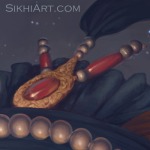Artist's Notes
“When He comes to mind, I am in supreme bliss.”
– Guru Arjun Dev ji (Guru Granth Sahib, 1141)
My newest painting depicting Dashmesh Pita – Guru Gobind Singh ji – is a reminder that through the Guru’s teachings we can illuminate the darkness in the mind. In this painting, Dashmesh Pita reflects Akal Purakh’s light, the way the moon reflects the sun, and when we bathe in Guru Sahib’s warmth, we become warm ourselves.
The Guru teaches us to –
ਜਾਲਿ ਮੋਹੁ ਘਸਿ ਮਸੁ ਕਰਿ ਮਤਿ ਕਾਗਦੁ ਕਰਿ ਸਾਰੁ ॥
ਭਾਉ ਕਲਮ ਕਰਿ ਚਿਤੁ ਲੇਖਾਰੀ ਗੁਰ ਪੁਛਿ ਲਿਖੁ ਬੀਚਾਰੁ ॥
ਲਿਖੁ ਨਾਮੁ ਸਾਲਾਹ ਲਿਖੁ ਲਿਖੁ ਅੰਤੁ ਨ ਪਾਰਾਵਾਰੁ ॥੧॥
Burn attachment to persons and materials and let this be your ink, let your intelligent mind be the paper.
Let love be the pen, let one-pointed consciousness be the scribe, and then ask the Guru for his wisdom and write down what he says.
On your mind-paper, write His name and His praises again and again, keep writing this. – Guru Nanak Dev (Guru Granth Sahib, 16)
He also tell us the result –
ਅੰਤਰਿ ਰਾਮ ਰਾਇ ਪ੍ਰਗਟੇ ਆਇ ॥ ਗੁਰਿ ਪੂਰੈ ਦੀਓ ਰੰਗੁ ਲਾਇ ॥੧॥ ਰਹਾਉ ॥
Inside me the light of the supreme king Ram has appeared, ever since the perfect guru has inspired me to love Him. – Guru Arjun Dev (Guru Granth Sahib, 1141)

These teachings are embedded into the painting in symbolic representations. Perhaps that’s why this painting is huge – it is seven feet tall – or perhaps Guru Sahib’s larger than life personality requires a larger than life portrait!
This is a puratan dumalla. At that time, sikhs tied dumalla very differently from how we tie dumalla nowadays. The slanted wraps were common in turbans during Guru Sahib’s time.
Think of dumalla as an organism that has evolved over many centuries. The earliest form of the dumalla was worn by our gurus and this dumalla then evolved during the period of Sikh Raj and British Raj into what it is today. Due to centuries of evolution, the earliest form of dumalla looks nothing like the modern one.

The King of Kings, Guru Sahib wears jewelry similar to other Mughal and Rajput kings of his time. He has a goldeng kalgi with red and white pearls, and a heron’s plume embedded with more pearls. He wears different necklaces made of pearls, gold and expensive stones.

Sukh Ghatoura –
Perfect! I love it veer! Thank you very much, so pleased with it!
Jagmeet Mohar (verified owner) –
Harijot Singh –
I have gratefully received the Dasmesh Pita canvas and it is hanging in our living room. I will cherish it for a long time to come!
Amit Pawa –
A. K. Dulai (verified owner) –
My neighbour came over today and I showed her the painting and she was totally mesmerised by it. To date, your paintings are one of the most precious items I have ever purchased.
K. Singh (verified owner) –
The prints are amazing
Many thanks
Gurshahbaz Singh (verified owner) –
Bohot bohot shukriya tuhada
Guru Nanak sahab bhali karan ge !!
Ravneet Kaur (verified owner) –
Beautiful!! Thank you so much.